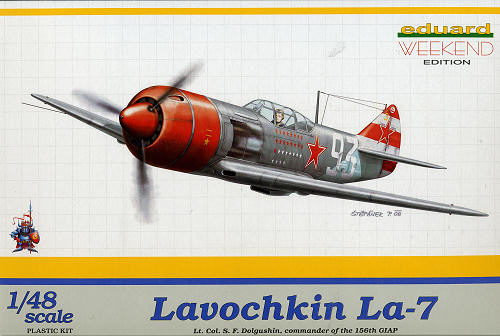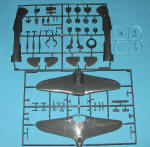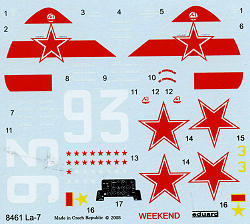
| KIT #: | 8461 |
| PRICE: | $ |
| DECALS: | One option |
| REVIEWER: | Scott Van Aken |
| NOTES: | 'Weekend Special' |

| HISTORY |
By 1943, the La-5 had become a mainstay of the Soviet Air Force, yet both its head designer, Semyon Lavochkin, as well as the engineers at TsAGI ("Central Aerohydrodynamics Institute") felt that it could be improved upon. The LaGG-1 had been designed at a time when it was considered necessary to conserve strategic materials such as aircraft alloys, and had a structure built almost entirely of plywood. With Soviet strategists now confident that supplies of these alloys were unlikely to become a problem, Lavochkin began replacing large parts of the airframe (including the wing spars) with alloy components. Various other streamlining changes were made as well, increasing performance further. The prototype, internally designated La-120 by Lavochkin, flew in November, and was quickly put into production, entering service the following spring.
The La-7 earned itself a superb combat record by the end of the war, and was flown by the top two Soviet aces of the conflict, one of which was Ivan Nikitovich Kozhedub. Turning a full circle took 19-21 seconds. The aircraft was also used as a test bed to explore advanced propulsion systems, including a tail-mounted liquid-fuelled rocket engine (La-7R), two under-wing pulsejets (La-7D), and two under-wing ramjets (La-7S). None of these variants proved worth pursuing, and turbojet technology quickly overtook them.
The La-7 was the only Soviet fighter to shoot down a Messerschmitt Me-262, by Ivan Nikitovich Kozhedub on one occasion over Germany on February 15, 1945.
Two La-7s from the PLAAF successfully shot down a Cathay Pacific airliner off the coast of Hainan Island in 23 July 1954.
Total production of the La-7 amounted to 5,753 aircraft, including a number of La-7UTI trainers. Those aircraft still in service after the end of the war were given the NATO reporting name Fin. The follow-up model, La-9 despite its outward similarity was a complete reworking of the design.
| THE KIT |
 One of
the best ideas Eduard ever had was to develop the 'weekend special' line of
kits. These are bare bones kits with no photo-etch or resin and just a single
markings option. There is not even a separate color and painting guide for the overall
airframe, that being shown on the box art and the sides of the box is considered enough.
One of
the best ideas Eduard ever had was to develop the 'weekend special' line of
kits. These are bare bones kits with no photo-etch or resin and just a single
markings option. There is not even a separate color and painting guide for the overall
airframe, that being shown on the box art and the sides of the box is considered enough.
The two main sprues are very nicely molded and show just how simple a kit the La-7 actually is. The lack of alignment pins and sockets keeps away any problems with sink areas and the ejector pin marks are limited to some small stubs on the inside of the wings, tailplanes and fuselage. These will be hidden once the kit is built.
 The
cockpit is equally basic with a seat, stick, pedals and some sidewall detail
bits. Interestingly, the first step in the construction is the wheel well
bulkhead and oil cooler inlets. The prop has separate blades that are keyed and
thanks to the large cooling fan, no engine is required, cutting back on painting
time. A three piece canopy is given, though there is no indication that this is
designed to be able to be left open.
The
cockpit is equally basic with a seat, stick, pedals and some sidewall detail
bits. Interestingly, the first step in the construction is the wheel well
bulkhead and oil cooler inlets. The prop has separate blades that are keyed and
thanks to the large cooling fan, no engine is required, cutting back on painting
time. A three piece canopy is given, though there is no indication that this is
designed to be able to be left open.
Instructions are well illustrated on a single folded sheet. All color data is with Gunze paints, a bit of a bummer for Americans now that this paint is no longer being imported. Fortunately, the AMT colors are provided in some cases so you can use alternate paints. The decal markings option is for the very late war aircraft of Col. S.F. Dolgushin, commander of the 156 GIAP. This plane has a full red nose and a red/white striped fin/rudder. This plane has no upper wing insignia and is AMT-11 grey upper with AMT-7 undersides, so no fancy camouflage scheme. Decals are well printed and include a decal for the instruments.
| CONCLUSIONS |
Another fine kit and a real boon to those whose modeling budgets have nearly disappeared. It will be interesting to see if this can actually be completed in a weekend. I started on it after supper on Friday past and if all goes according to plan, it should be finished by the time you read this. You'll find out how it turned out on this coming Friday.
| REFERENCES |
http://en.wikipedia.org
November 2008 Thanks to
www.eduard.cz for providing the preview kit. If you would like your product reviewed fairly and quickly, please
contact
me or see other details in the
Note to
Contributors.